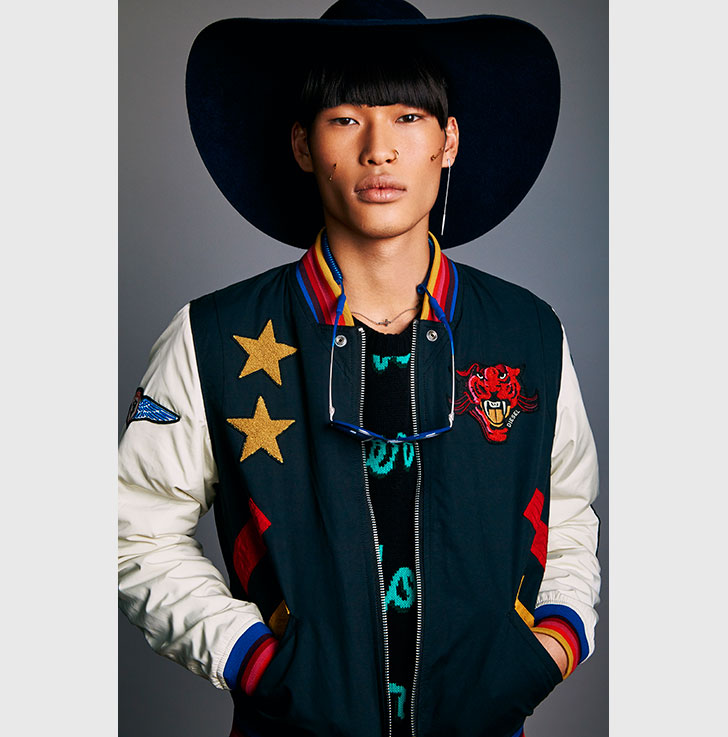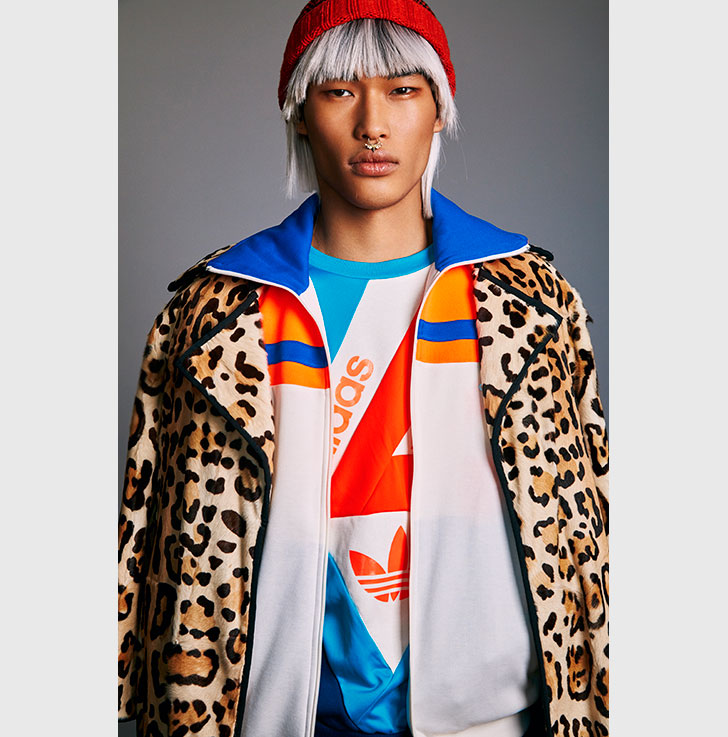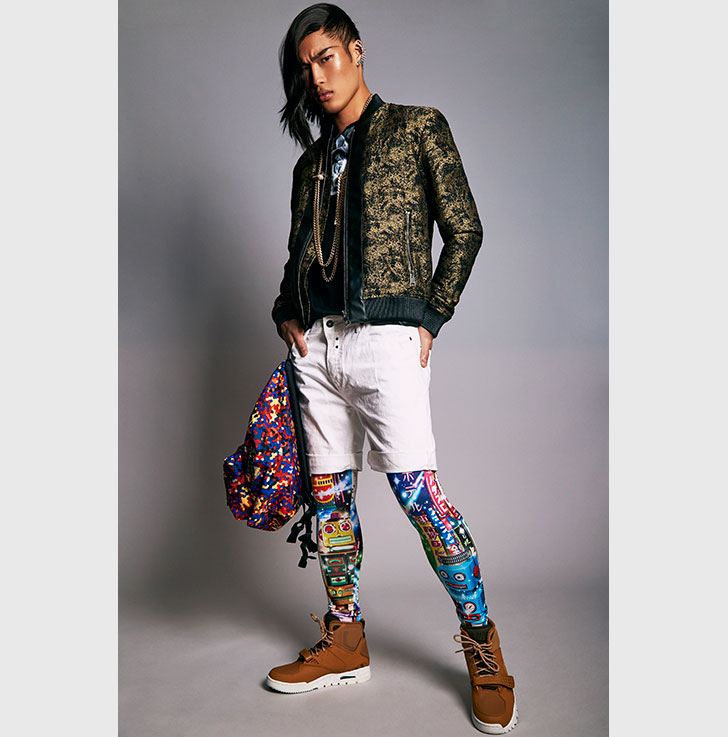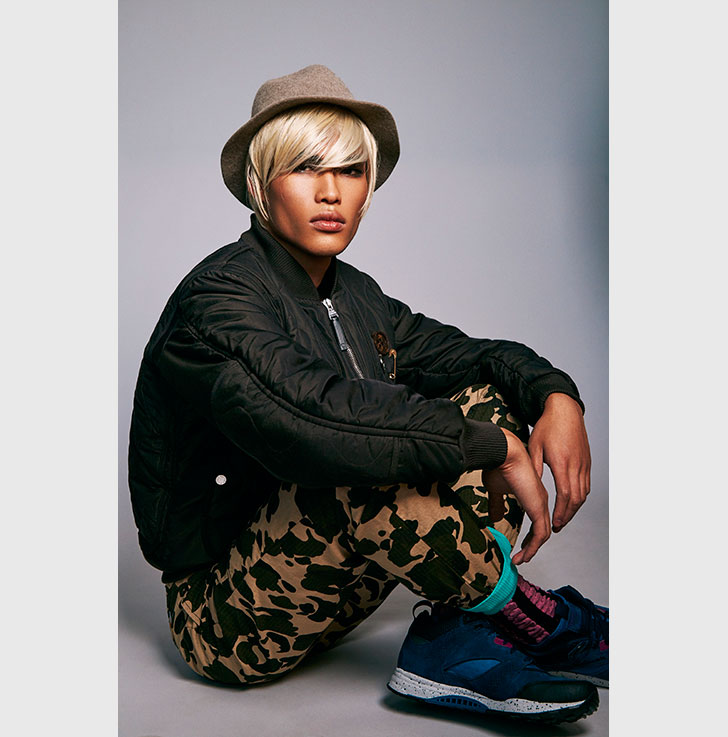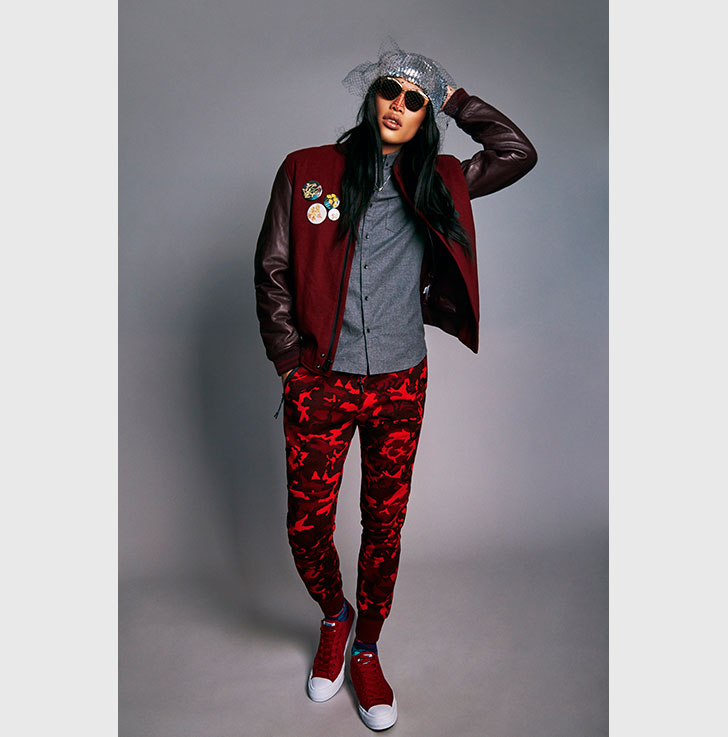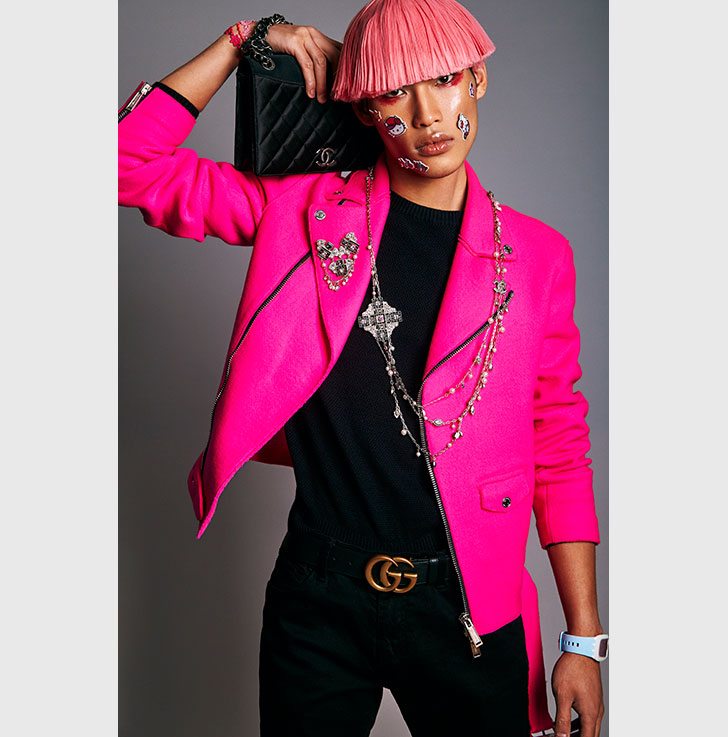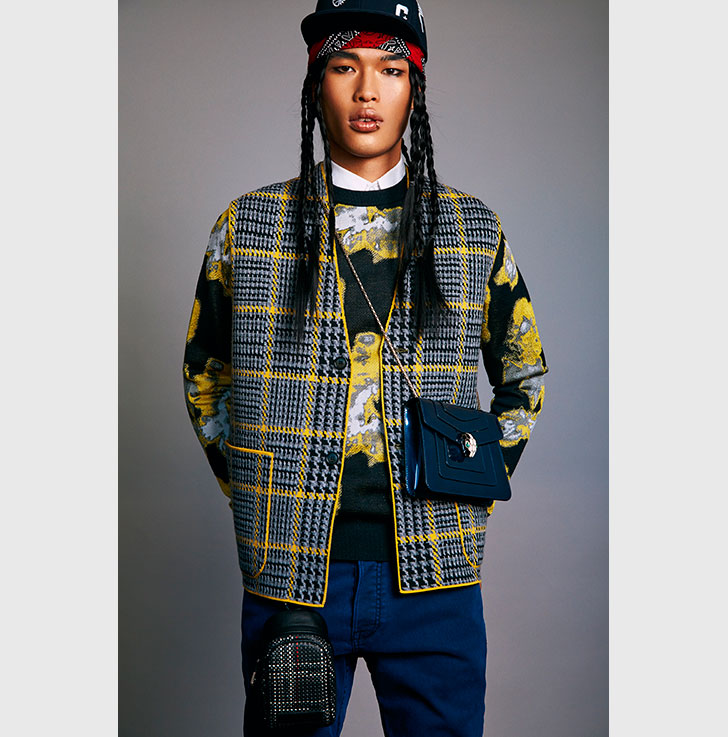Mientras en los 90 Corea del Norte amenaza al mundo con su programa nuclear, los surcoreanos crean el K-Pop. Aparentemente una inofensiva estética musical. Quizás una sofisticada y sigilosa arma para vengarse de los años de ocupación japonesa, conquistar el mundo y anular a los enemigos del norte, unificando a las 2 coreas. En este artículo interpretamos las claves y uniformes de las tropas K-Pop.
————————–
Fotografía: Danniel Rojas
Estilismo: Javier de Juanas
Maquillaje: Javier Sevillano
Peluquería: Jesús de Paula para Ghd España
Asistente Estilismo: Carlos Marló
Retoque Digital: Rafa Seoanes
Modelo: Chun @ Trend Models
Texto: Mongómeri
————————–
Foto Arriba: Sombrero Hermès + Bomber Diesel + Jersey Pull&Bear + Gafas Emporio Armani + Collar & Pendientes Aristocrazy
————————–
In the Nineties, whilst North Korea was threatening the rest of the world with their nuclear plans, the South Koreans were creating K-Pop. It’s a seemingly inoffensive style of music. It’s also potentially a sophisticated and stealthy weapon to get back at the years of Japanese occupation, conquering the world and wiping out those enemies in the North, uniting both Koreas. In this issue we take a look at its key features and those K-Pop troops’ uniforms.
Corea del Sur es el nuevo Japón. Todo lo que hacen mola. El país, acompañado de una privilegiada situación económica y un alto desarrollo tecnológico, vive, desde los años 90, una explosión de creatividad en múltiples disciplinas. Incluso ha desarrollado su propio subgénero musical: El K-Pop, una corriente, musical y estética, teledirigida por el propio gobierno. Su nombre lleva implícito una auténtica declaración de principios: Korean Pop. La denominación de origen genérica tendría como propósito unificar mentalmente las 2 Coreas bajo el, mucho más apetecible, life style surcoreano, contexto geo-socio-político donde nace este movimiento (todo el mundo sabe que en Corea del Norte el pop brilla por su ausencia). De hecho, la idea de unir, fusionar y globalizar forma parte de la esencia del K-Pop, subgénero que se define por fagocitar los estilos más generalistas de la música contemporánea: pop, tecno, electro, hip-hop, dance, rock… o lo que se tercie. Todos los géneros se mezclan en esta poderosa termomix “made in south corea”. Los únicos géneros que no se mezclan son los sexuales.
————————–
Foto Arriba: Sudadera & Chaqueta adidas Originals + Abrigo Miguel Marinero + Septum Claire’s
————————–
South Korea is the new Japan. Everything they do is cool. The country, accompanied by a privileged economic situation and a huge level of technological development, is going through a burst of creativity in many disciplines. They’ve even developed their very own pop sub genre: K-Pop, a trend, both musical and aesthetic, that’s guided by the government. The name even implicitly carries a true declaration of their principles: Korean Pop. At its core, this generic denomination of origin might have the aim of mentally unifying the two Koreas under the (far more appealing) South Korean lifestyle, the geo-social-political context where this movement was born (we all know that there’s a distinct lack of pop in North Korea). In fact, the idea of uniting, fusing and globalising forms part of K-Pop’s very essence – it’s a sub genre that is defined by the gobbling up of contemporary music’s most general styles: pop, techno, electro, hip-hop, dance, rock… or whatever. All the genres are blended in this powerful “made in South Korea” blender. The only thing you don’t mix are genders.
El ejercito K-Pop está formado por batallones de chicos o de chicas, nunca juntos. Cada batallón está formado por 4 o 7 soldados meticulosamente formados en costosas escuelas desde edades tan tempranas como los 9 o 10 años. De estas fábricas de estrellas -fugaces, en la mayor parte de los casos- pueden salir anualmente más de medio centenar de formaciones dispuestas a arrasar el mundo. El sistema parece similar al de la industría futbolística de occidente. Mientras que aquí los niños quieren ser futbolistas, a los de allí les gustaría ser artistas del K-Pop. Algo para lo que no basta nacer, también hay que hacerse. Los niños no solo estudian canto y danza, imprescindible para realizar las milimétricas, y hasta acrobáticas, coreografías que ejecutan en equipo, sino también técnicas de comunicación para relacionarse con los periodistas y con los fans. Todo parece cuidadosamente estudiado para conquistar al mundo juvenil y a la opinión pública internacional. El youtube es el nuevo portaaviones desde el que bombardearnos sin piedad.
————————–
Foto Arriba: Camiseta Antony Morato + Bomber Just Cavalli + Leggings Rubén Galarreta + Bermudas Pull&Bear + Zapatillas Nike + Mochila Eastpak + Collar Chanel + Pendientes Clairé’s
————————–
From these star producing factories – shooting stars, in the majority of cases – every year more than fifty formations can come out, all set to conquer the world. The system seems similar to that of the football industry in the West, but whilst here kids want to be footballers, over there they want to be K-Pop artists. Something that you’re not just born to do, you have to work at: the kids study singing and dancing, essential to performing the precise, even acrobatic, choreographies that they carry out in sync, but they also learn communication techniques so they can relate to journalists and fans. Everything seems carefully studied for conquering the world and the international public’s heart. YouTube is the new aircraft carrier from which they will mercilessly drop K-Pop bombs on us.
Como cualquier ejército que se precie, el K-Pop también tiene su propio uniforme, muy ecléctico eso sí. Con una clara influencia del manga japonés y los estilismos que sorprendieron al mundo a comienzos de los 90 desde las calles de Shibuya, su estética, muy marquista, ensalza el maquillaje, los colores muy vivos, las mezclas explosivas y los prints gráficos con toques naif. Toda esta expresividad contrasta a su vez con una vertiente más elegante y formal de algunos intérpretes de K-Pop que heredan siluetas propias del vestuario masculino de la primera mitad del siglo 20. Una tendencia que les asocia a la corriente Black Dandy que surge desde Brooklyn, París o lo más profundo de África. Todo esto delata un profundo conocimiento de la historia de la moda. No son solo cantantes que bailan, han sido formados como auténticos embajadores para las marcas de moda. Sus artífices son conscientes de que la combinación de música, estética y comercio es un arma poderosísima de conquista, mucho más efectiva a largo plazo que cualquier arma de destrucción masiva.
————————–
Foto Arriba: Gorro Dsquared2 + Bomber & Broches Louis Vuitton + Pantalón Carhartt Wip + Calcetines Happy Socks + Zapatillas Reebok
————————–
Just like any army worth its salt, K-Pop also has its own uniform – which yes, is very eclectic. With a clear influence taken from Japanese manga and the styles that shocked the world at the beginning of the Nineties from the streets of Shibuya, their lively aesthetic, very marked, is all make-up with very bright colours, explosive mixes and graphic prints with naïve touches. All of this expressivity contrasts with a more elegant and formal look in some of K-Pop’s stars, more influenced by the aesthetic of the first half of the Twentieth century or more recent Black Dandys out of Brooklyn, Paris or deepest Africa. This all reveals a profound knowledge of the history of fashion. They are not just singers who dance, they’ve been trained as real ambassadors for fashion brands. Their architects are more than aware of the fact that a combination of music, aesthetic and commerciality is an extremely powerful weapon for conquering, far more effective in the long run than any weapon of mass destruction.
Todo parece un perfecto plan orquestado por los surcoreanos para conquistar el mundo, vengarse de la ocupación japonesa y unificar las 2 coreas. No hay que olvidar el shock sufrido por Corea durante la primera mitad del siglo 20. Lo que era un país ajeno al resto del mundo fue tomado por los japoneses desde 1905 hasta 1945, años en los que estos declararon la guerra a medio mundo. Su rendición coincide con el fin de la Segunda Guerra Mundial, pero el conflicto coreano continua. Ahora serán los Estados Unidos y la Unión Soviética los que intenten hacerse con el país. Un tira y afloja que, finalmente en 1948, fragmenta Corea en 2: la del Norte, más comunista, y la del Sur, más capitalista. Pasando así de ser un país tradicionalmente aislacionista, a todo lo contrario, me refiero a Corea del Sur, muy influenciada por el life style americano. Un estilo de vida que vivieron muy de cerca durante los 50, época en la que el ejercito estadounidense estuvo presente en la zona para hacer frente a la amenaza comunista del norte. Sin duda, y como todo se pega, ese fue el germen de la creación del K-Pop.
————————–
Foto Arriba: Camisa Hominem + Bomber & Pantalón Nike + Zapatillas Converse + Calcetines Happy Socks + Chapas & Colgante Dior Homme + Gorro & Gafas Christian Dior
————————–
It all seems like a perfectly orchestrated plan by the South Koreans to conquer the world, get their own back at the Japanese for the occupation and unite the two Koreas. You can’t forget the shock that Korea went through in the first half of the Twentieth century. What had been a country quite removed from the rest of the world was taken by the Japanese from 1905 to 1945, the years in which they declared war on half of the rest of the world. Their surrender coincided with the end of the Second World War, but conflict in Korea continued. Then it was the turn of the US and the Soviet Union to have their way with the country. A push and pull that, finally in 1948, broke Korea in two: the North, more communist, and the South, more capitalist. And so it went from a country that was traditionally isolationist to one that was completely the opposite. I mean South Korea, highly influenced by the America lifestyle. A lifestyle that they experienced very close up during the Fifties, the years in which the American army was present in the zone to control the communist threat in the North. Like everything, something doubtlessly rubbed off, and that was the seed that would grow into the creation of K-Pop.
A pesar del armisticio declarado en 1953, las 2 coreas siguen oficialmente en guerra. Pero mientras la del norte amenaza al mundo con programas nucleares, la del sur crea el K-Pop, un instrumento creativo del gobierno surcoreano para conseguir sus fines. Promotores del K-Pop Festival World en todo el mundo -en España vamos por la cuarta edición-, los políticos de Corea del Sur son conscientes de que la música y la moda, en definitiva la creatividad, son elementos que ayudan a crear buena imagen de un país. En este caso, la imagen que interesa transmitir es la de modernidad, sinónimo de tecnología, ya que Corea del Sur es una de las principales industrias tecnológicas del mundo, y las exportaciones son claves para su PIB. Pero más allá de los objetivos económicos, y vengarse de los japoneses convirtiéndose en un país mucho más molón, Corea del Sur persigue la unificación a través del K-Pop. Su influencia está llegando a los jóvenes vecinos del norte, los cuales comienzan a seguir ciertas tendencias estilísticas del K-Pop, llegando incluso a desafiar algunas de las estrictas normas que impone el Estado en lo que se refiere a indumentaria. De hecho, ya se habla de K-Pop norcoreano. La revolución está en marcha. Lo que una el maquillaje y el estilismo que no lo separe el hombre.
————————–
Foto Arriba: Jersey Hominem + Cazadora Dsquared2 + Pantalón Pull&Bear + Cinturón Gucci + Broche & Bolso Chanel + Pulseras Crucciani + Reloj Swatch
————————–
Despite the truce declared in 1953, the two Koreas are still officially at war. But while the North threatens the world with nuclear weapons, the South has come up with K-Pop, a creative instrument from the South Korean government to achieve its ends. Promoters of the K-Pop Festival World – which has had four editions now -, South Korean politicians are more than aware of the impact that music and fashion, or more specifically creativity, can have in being tools that help to create a positive image of a country. In this case, the image they are interested in transmitting is one of modernity, a synonym of technology, because South Korea is one of the main technological industries of the world, and their exports are key to their Gross Domestic Product. But beyond their economic aims, and getting back at the Japanese by becoming a way cooler place, South Korea is trying to unify the country using K-Pop. Their influence is reaching their young neighbours in the North, who are starting to follow certain aesthetic K-Pop trends, even going so far as to rebel against the strict rules that the State imposes with regards to attire. In fact, they’re already talking about Northern K-Pop. The revolution has well and truly begun. That which unites make-up and style let no man tear asunder.
————————–
Foto Arriba: Jersey Just Cavalli + Gafas Carrera + Pendiente Aristocrazy + Abrigo Piel Etxeberria + Reloj Mark Maddox + Pulsera Thomas Sabo + Pantalón Pepe Jeans London + Zapatillas Onitsuka Tiger
————————–
Este artículo fue publicado en el número de noviembre de Neo2 Magazine. Puedes leer más artículos como este haciendo click en FREE ISSUES
————————–
This article was published in the November issue of Neo2 Magazine, you can read more articles like this in english clicking FREE ISSUES
————————–
————————–
Foto Arriba: Jersey, Chaleco & Monedero Dior Homme + Pantalón U Adolfo Dominguez + Bandana & Gorra Carhartt Wip + Bolso Bulgari
————————–


